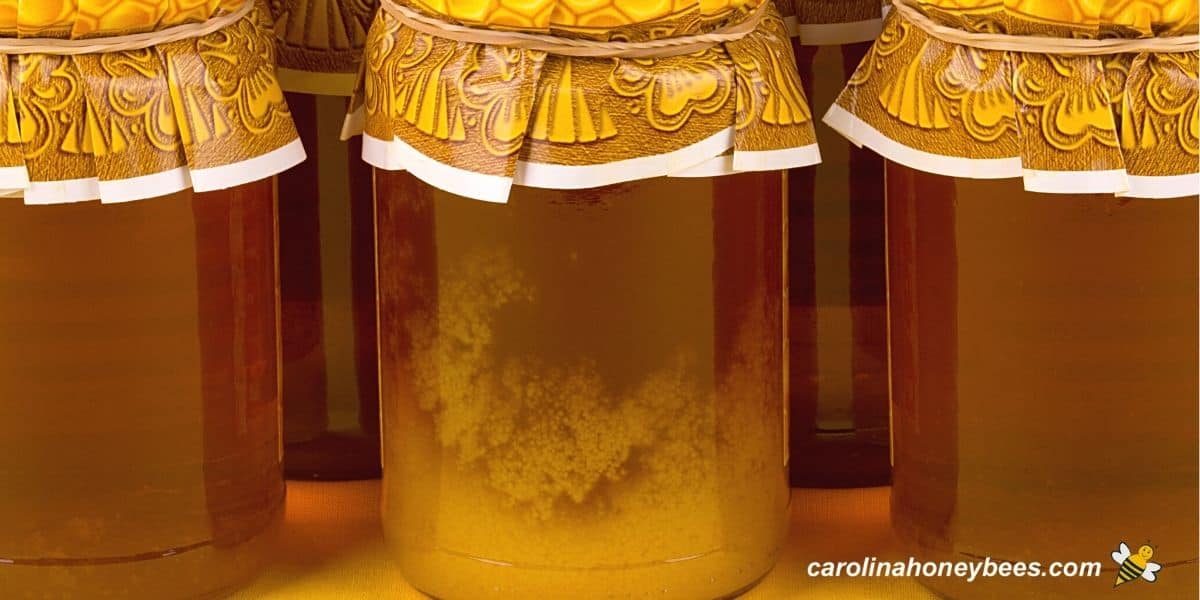On this website, some posts contain affiliate links, which means that if you buy a product using my link, I may earn a commission.
To decrystallize honey in a plastic container, place the container in a warm water bath and let it sit until the honey becomes liquid again.
1. Why Does Honey Crystalize?
To decrystallize honey in a plastic container, a simple method is to place the container in a warm water bath, ensuring not to exceed 108°F (42°C). Gently stir the honey until it becomes smooth and liquid again.
Honey is a natural sweetener that is loved by many for its unique taste and numerous health benefits. However, you may have noticed that over time, honey stored in a plastic container can become thick and grainy, with a process known as crystallization. But why does honey crystallize?
Factors That Contribute To Honey Crystallization
Several factors can contribute to the crystallization of honey. Understanding these factors can help you prevent or manage the crystallization process:
- Temperature: Honey crystallizes faster at cooler temperatures. If the storage temperature of your honey drops below 50°F (10°C), you’re more likely to experience crystallization.
- Water Content: The water content of honey plays a crucial role in its crystallization. Honey with higher water content is more prone to crystallization.
- Type of Honey: The type of honey can also influence its crystallization. Some types of honey, such as clover and rapeseed honey, tend to crystallize more quickly compared to others.
- Pollen Content: Honey with a high pollen content is more likely to crystallize. Pollens act as crystallization nuclei, providing a structure for the sugar molecules to form crystals around.
- Storage Conditions: Exposure to air and light can speed up the crystallization process. It’s recommended to store honey in an airtight container away from direct sunlight.
Benefits And Drawbacks Of Crystallized Honey
While many people prefer their honey in its liquid, smooth form, crystallized honey can also have its benefits:
| Benefits | Drawbacks |
|---|---|
|
|
Now that we understand why honey crystallizes and the benefits and drawbacks associated with it, let’s move on to the methods of decrystallizing honey in a plastic container.
2. The Quick And Easy Method: Using Warm Water
One quick and easy method to decrystallize honey in a plastic container is by using warm water. Simply submerge the container in warm water and let the heat melt the crystals, making the honey smooth and pourable again.
Step-by-step Guide To Decrystallizing Honey In A Plastic Container
When it comes to decrystallizing honey in a plastic container, the quick and easy method is to use warm water. This method is perfect for those who need their honey to be in its liquid form immediately. Follow these steps to enjoy smooth, runny honey once again:
- Fill a large bowl or sink with lukewarm water. Make sure the water temperature is not too hot, as it can damage the plastic container.
- Place the plastic container of crystallized honey into the lukewarm water. Ensure that the container is tightly sealed to prevent any water from getting inside.
- Let the container sit in the warm water for about 10 to 15 minutes. The lukewarm temperature will gradually heat the honey and melt the crystallized sugar.
- After the specified timeframe, carefully remove the plastic container from the warm water. Make sure to dry the container before opening it, as any water droplets can affect the quality of the honey.
- Give the container a gentle shake or stir to further mix the honey and break up any remaining crystals. If needed, you can repeat the process for a longer duration until the honey reaches the desired consistency.
The Importance Of Using Lukewarm Water
Using lukewarm water is crucial when decrystallizing honey in a plastic container. Exposing honey to high temperatures can cause the plastic container to release harmful chemicals, which may compromise the quality of the honey. Lukewarm water provides enough heat to melt the crystallized sugar without risking any damage to the container or the honey itself. It ensures a safe and effective decrystallization process.
Timeframe For Decrystallization
The timeframe for decrystallizing honey using warm water may vary depending on the amount of crystallization and the temperature of the water. In general, letting the plastic container sit in lukewarm water for about 10 to 15 minutes should be sufficient to achieve the desired results. However, if the honey remains partially crystallized after this timeframe, you can prolong the process by leaving it in the water for an additional 5 to 10 minutes. Remember to monitor the water temperature and make adjustments as needed to avoid overheating or damaging the honey.
3. Tips For Decrystallizing Honey Successfully
Learn how to decrystallize honey in a plastic container without damaging its quality. Find out the best tips and techniques for successfully restoring your honey to its smooth and liquid state.
When your honey has crystallized in a plastic container, you may think it’s time to toss it out. But fear not, there’s a simple solution: decrystallizing it. In this section, we’ll share three essential tips to help you successfully decrystallize honey and restore its liquid consistency.
Temperature Guidelines For Warm Water
One effective way to decrystallize honey is by using warm water. However, it’s crucial to maintain the right temperature to prevent any damage to the plastic container or altering the honey’s quality. Make sure the water is heated to a maximum temperature of 45 degrees Celsius. Any higher temperature may risk impairing the honey’s flavor and nutritional value. By adhering to this temperature guideline, you can safely and effectively decrystallize your honey.
How To Prevent Water From Entering The Honey
While warm water is vital for decrystallizing honey, it’s equally crucial to prevent any moisture from entering the honey itself. Water contamination can lead to fermentation and spoilage. To ensure no water enters your honey during the decrystallization process, follow these steps:
- Tightly seal the plastic container to prevent water from seeping in.
- Place the container upright in a larger bowl or basin.
- Add warm water to the larger bowl or basin, ensuring that the water level stays below the plastic container’s lid.
By implementing these precautions, you’ll effectively shield your honey from water contamination, guaranteeing that its taste and quality remain intact.
Best Storage Practices To Avoid Future Crystallization
If you want to prevent future crystallization of your honey, it’s essential to store it properly. Follow these best practices:
- Avoid exposing honey to extreme temperatures. Store it at a moderate temperature, ideally between 10 to 21 degrees Celsius.
- Keep your honey in a cool, dark place away from direct sunlight. Sun exposure accelerates crystallization.
- Avoid mixing honey with other liquids or foods as it can introduce moisture content and increase the likelihood of crystallization.
By adopting these storage practices, you can extend the shelf life of your honey and minimize the chances of it crystallizing again.
4. Alternatives To Warm Water Method
When it comes to decrystallizing honey in a plastic container, using warm water is a popular method. However, there are alternative methods that can also effectively restore your honey to its smooth, liquid state. In this section, we will explore two alternative methods for decrystallizing honey: the microwave method and the sous vide method.
Exploring Other Methods For Decrystallizing Honey
If you’re looking for alternatives to using warm water to decrystallize your honey, you might want to consider the microwave method or the sous vide method. Both of these methods have their own pros and cons, so let’s take a closer look at each one.
Microwave Method: Pros And Cons
If you’re in a hurry and need to decrystallize your honey quickly, the microwave method might be the ideal option for you. Here are the pros and cons of using the microwave method:
| Pros | Cons |
|---|---|
| Easily accessible and convenient | May cause honey to overheat and lose some of its nutritional value |
| Quick and efficient | Requires careful monitoring to prevent honey from boiling or overflowing |
| Can be done in small increments to avoid overheating | Potential risk of honey exploding if not properly sealed |
Sous Vide Method: Benefits And Considerations
The sous vide method is a more controlled and precise way of decrystallizing honey. This method involves immersing the honey container in a water bath with a sous vide immersion heater or a sous vide water vessel. Here are the benefits and considerations of using the sous vide method:
- Benefits:
- Temperature can be accurately regulated, preventing the honey from overheating or boiling.
- Preserves the nutritional value and taste of the honey.
- Does not require constant monitoring, allowing you to set it and forget it.
- Considerations:
- Requires a sous vide immersion heater or a sous vide water vessel.
- Takes longer compared to the microwave method.
- Requires proper sealing of the honey container to prevent water from entering.
When using any alternative method to decrystallize honey, it is important to ensure that the container is suitable for microwave or sous vide use, and that you follow the manufacturer’s instructions for proper use and safety precautions.
5. Additional Tips And Faqs
Learn how to decrystallize honey in a plastic container with these additional tips and frequently asked questions. Avoid damaging the honey by using a sous vide immersion heater or sous vide water vessel for a precise and safe decrystallization process.
Can Honey Be Decrystallized Multiple Times?
It is not recommended to decrystallize honey multiple times, as repeated heating and cooling can cause it to lose its unique flavor. It is best to decrystallize only the amount of honey you need and store the rest in its crystallized form.
How To Soften Honey In A Plastic Bottle?
If you have crystallized honey in a plastic bottle that needs to be softened, there are a few simple steps you can follow:
- Fill a bowl with warm water, making sure it is not too hot to touch.
- Submerge the plastic bottle of honey in the warm water, ensuring that the water level is below the lid.
- Leave the bottle in the warm water for about 10-15 minutes, allowing the heat to gradually soften the honey.
- Once the honey has softened, gently stir it with a spoon to ensure an even consistency.
- Remove the bottle from the warm water, dry it off, and enjoy your softened honey!
How To Store Decrystallized Honey For Long-term Freshness?
Proper storage is essential to maintain the freshness and quality of your decrystallized honey. Here are some tips:
- Use an airtight container to store your decrystallized honey, ensuring that it is completely sealed to prevent exposure to air and moisture.
- Store the honey at room temperature in a cool and dry place, away from direct sunlight.
- Avoid storing honey in the refrigerator, as the cold temperatures can cause it to crystallize more quickly.
- Label the container with the date of decrystallization to keep track of its freshness.
- Regularly check the honey for any signs of spoilage, such as mold or off-flavors. If you notice any abnormalities, discard the honey.
By following these storage tips, you can ensure that your decrystallized honey stays fresh for a longer period, allowing you to enjoy its delicious taste and numerous health benefits.


Credit: carolinahoneybees.com
Frequently Asked Questions Of How To Decrystallize Honey In A Plastic Container
How Do You Decrystallize Raw Honey In A Plastic Bottle?
To decrystallize raw honey in a plastic bottle, place the bottle in a bowl of warm water. Let it sit for about 10-15 minutes until the honey becomes liquid again. Avoid microwaving as it can damage the plastic bottle.
Can You Microwave Honey In Plastic?
Yes, you can microwave honey in plastic, but be cautious to use microwave-safe containers and heat it in short intervals, stirring in between to prevent overheating and melting of the plastic.
How Many Times Can You Decrystallize Honey?
Decrystallize honey only once. Repeated heating and cooling can affect its flavor. Avoid unnecessary decrystallization.
Will Microwaving Honey Decrystallize It?
Microwaving honey will decrystallize it quickly and easily.
Conclusion
To decrystallize honey in a plastic container, there are several methods you can try, including using hot water baths or sous vide cookers. It’s important to be cautious with the temperature to prevent any damage to the plastic container. Additionally, avoid reheating honey multiple times as it can affect its flavor.
Overall, decrystallizing honey is a simple process that can help restore its smooth texture and make it easier to use in various recipes.
On this website, some posts contain affiliate links, which means that if you buy a product using my link, I may earn a commission.

